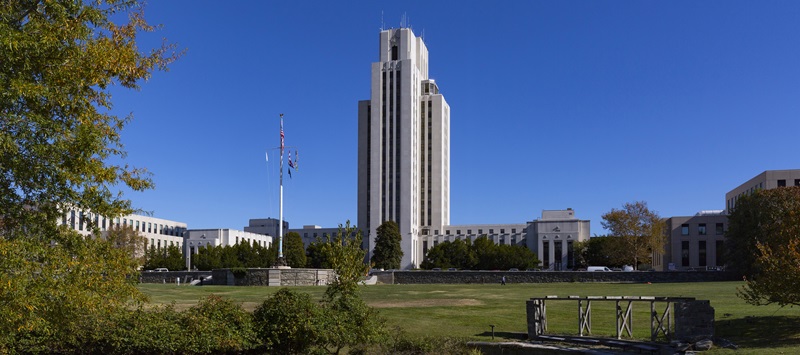About Us

Celebrating Two Proud Histories
Walter Reed Army Medical Center
Walter Reed General Hospital opened its doors on May 1, 1909. The Commander of the Army General Hospital, Major William C. Borden had lobbied for several years for a new hospital to replace the aged one at Washington Barracks, now Ft. McNair.
Borden and Major Walter Reed, who became best known as the leading researcher to discover that yellow fever was transmitted by mosquitoes, became friends while teaching together at the Army Medical School. Sadly, one short year after his return trip from Cuba, Major Reed died from peritonitis following an appendectomy performed by his dear friend, Major Borden. Following Reed's death, Borden became dedicated to seeing the completion of the new hospital which would co-locate the Army hospital, the Army Medical School, the Army Medical Museum and the Surgeon General's Library. Borden was instrumental in naming the new hospital after his friend, Major Walter Reed.
In 1923, General John J. Pershing signed the order creating the Army Medical Center on the same campus as Walter Reed General Hospital. World War I saw the hospital's capacity grow from 80 patient beds to 2,500 in a matter of months. Through World War II, Korea and Vietnam, the facility treated hundreds of thousands of injured American soldiers. As the complex grew, a new Armed Forces Institute of Pathology building was built on the Walter Reed Army Medical Center campus in 1955, and the Armed Forces Institute of Pathology added an addition in 1971.
On September 26, 1977, the additional structures were dedicated by Walter Reed's granddaughter, Daisy Royce; President Dwight D. Eisenhower's widow, Mamie Eisenhower, and an array of military leaders. The hospital itself stood 125 feet, as tall as a 10-story building. There were 5,500 rooms covering 28 acres of floor space. The distance around the top three floors stretched the length of six football fields. The building was designed for the highest-quality patient care and comfort. It offered accommodations for 250 patients, admitting more than 14,000 a year.
In 1994, the main building was rededicated and was named the Heaton Pavilion. It honors the late LTG Leonard Heaton, a former commander of Walter Reed from 1953 to 1959, who served as the Army Surgeon General from 1959 to 1969. The Rumbaugh Parking Garage was dedicated in 1993, the Borden Pavilion in 1995, the Mologne House opened in 1997 and the Military Advanced Training Center opened in 2007. Walter Reed Army Medical Center served the nation for over 102 years.
National Naval Medical Center
President Franklin D. Roosevelt (FDR) selected the present site in Bethesda, Maryland, and ground was broken for the Naval Medical Center in 1939. FDR laid the cornerstone of the Tower on Armistice Day, November 11, 1940. The President's vision was to establish a Navy Medical Center that housed medical care, Navy medical training, Navy research and a medical library in one location.
The original Medical Center was designed to hold 1,200 beds, the Naval Medical School, the Naval Dental School, and the Naval Medical Research Institute. In 1945, temporary buildings were added to accommodate 2,464 wounded American Sailors and Marines from World War II. With the start of the Korean War, the Medical Center's capacity grew to 1,167 beds in 1951.
In August of 1960, a $5.6 million dollar expansion project was initiated and consisted of two five-story wings attached to the main building's east side, providing space for 258 beds which replaced the WW II temporary ward buildings. In 1968, during the Vietnam War, the bed capacity peaked at 1,122.
The 1970's brought much growth, when in 1973, the Naval Regional Health Care System was established, which placed all naval health care facilities within the Naval District Washington under authority of the Commander of the Medical Center and the same year the hospital was consolidated into one command to form National Naval Medical Center.
In 1975 an extensive renovation began which included the construction of two buildings: Building 9, a three-story outpatient structure, and Building 10, a seven-story, 500-bed inpatient facility, with a combined area of more than 880,000 square feet which made National Naval Medical Center one of the largest medical facilities in the country.
In 2003, over 1,000 of NNMC's medical staff members deployed on the USNS COMFORT serving in the Persian Gulf during OIF/OEF. They performed over 500 surgical procedures in less than four weeks and handled a major influx of maimed, wounded and sick patients and casualties, including American Soldiers and Marines, United Nations troops, and Iraqi POWs and civilians. Since then, NNMC has treated 1,539 service members, contract civilians and media personnel wounded in Operations Iraqi Freedom -Enduring Freedom.
Over the years, NNMC has served and cared for every President of the United States, members of Congress and the Supreme Court, and other leaders of our Nation. In 1977, the original Naval Medical Center tower was designated a historical landmark and entered into the Registry of Historical Places by the U.S. Department of the Interior.
The Base Realignment and Closure Act (BRAC) of 2005 closed both National Naval Medical Center and Walter Reed Army Medical Center culminating in the opening of Walter Reed National Military Medical Center on 15 September 2011 with the dedication ceremony occurring on 10 November 2011.
Forging Ahead
There has been no bigger, farther-reaching single event in the history of military medicine. The bringing together of these two great military medical centers on the grounds of the former NNMC in Bethesda, officially launched a huge and vital change in military medicine.
As Army, Navy, Air Force and Uniformed Services University health systems join together we continue to combine and respect our diversities and unique histories while reaping the benefits of a strong, united and energetic entity. Walter Reed National Military Medical Center is committed to a mission that we are honor-bound to pursue; that of providing world-class health care to our nation's fighting forces, retirees, and their families.